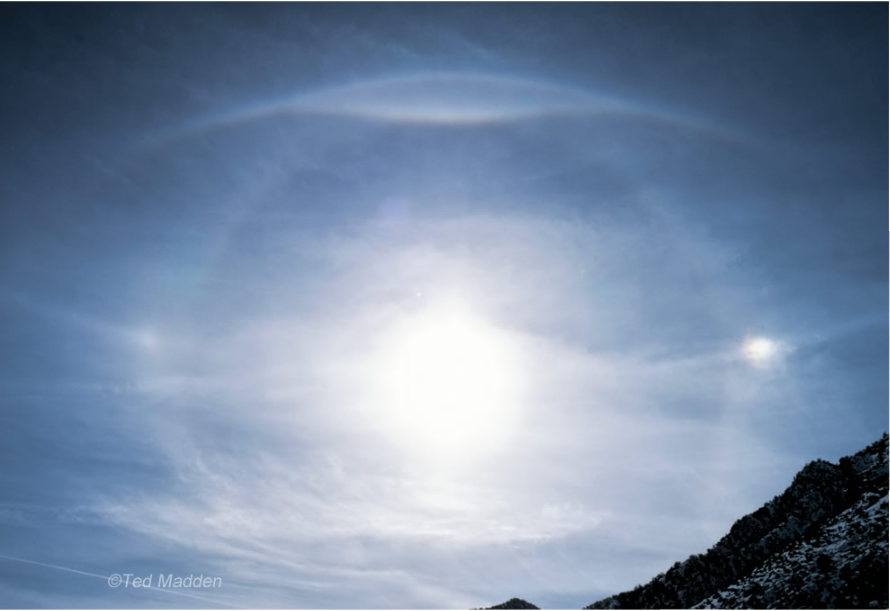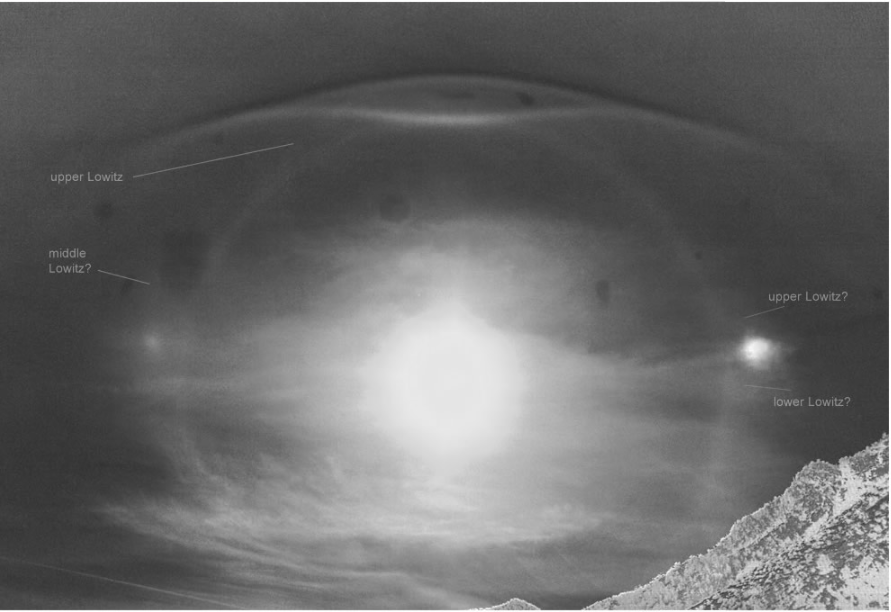1979 Lowitz Arcs - OPOD
1979 Lowitz Arcs: Unraveling the Enigmatic Halo Display
In January 1979, Ted Madden was fortunate enough to capture a mesmerizing halo display over southern Utah. Little did he know that his photograph would potentially be the first ever reported image showcasing the mysterious Lowitz arcs. These elusive arcs were clearly visible even before any enhancement, making them a remarkable find.
Lowitz arcs, named after Tobias Lowitz who drew them during a halo display in St. Petersburg, Russia in 1790, have been a subject of controversy ever since. Although searchers initially looked near sundogs, where Lowitz had drawn them, they were usually quite indistinct in that area. However, Madden's photograph reveals a different pattern. The upper Lowitz arc gracefully curves outwards from the 22° halo at 2 and 10 o'clock, eventually meeting the bright Parry arc at the top. Additionally, the 22° halo itself exhibits characteristic "Lowitz gaps" near the sundogs, and there are tantalizing hints of arcs extending towards the parhelia.
While Lowitz arcs had been described in literature, they had not been photographed until relatively recently, approximately two to three decades ago. Examples such as Robert Gorkin's images from 1988 and Petri Hakkarainen's from 1994 have provided valuable evidence of their existence. However, Madden's photograph pushes the timeline back even further to 1979, raising the question of whether earlier images might be hidden away in dusty cupboards waiting to be discovered.
To further analyze and enhance Madden's image, various techniques were employed, including color subtraction, levels adjustment, noise reduction, and slight embossing in Photoshop. These enhancements brought out subtle details, revealing hints of Lowitz arcs curving both upwards and downwards from the parhelia to meet the 22° halo. Notably, there is a possibility of a middle Lowitz arc on the left side, although it remains faint and elusive near the parhelia.
To better understand the formation of Lowitz arcs, HaloSim ray tracing was utilized. The simulated rays in red, representing Lowitz arcs, were shown at a higher crystal concentration for clarity. The simulations used thick and regular hexagonal plates, considering all orientations around the Lowitz axis AA. Through this analysis, a clearer understanding of the characteristics and behavior of Lowitz arcs can be gained.
In conclusion, Madden's 1979 photograph of the Lowitz arcs provides a valuable addition to the existing evidence of these enigmatic atmospheric phenomena. It highlights the importance of keen observation and serendipitous moments in capturing rare optical displays. As our knowledge and technology continue to advance, we may uncover even earlier images that shed further light on the mysteries surrounding atmospheric optics.

1979 Lowitz Arcs
Ted Madden saw this halo display over southern Utah in January 1979. �Would've missed this if we hadn't stopped to change drivers.� He was lucky indeed. This image is possibly the first ever reported that shows the enigmatic Lowitz arcs.
OPOD routinely searches any images sent in for Lowitz arcs. They are fairly obvious on this one even before any enhancement. There is an upper Lowitz curving outwards from the 22� halo at 2 and 10 o�clock to meet the bright Parry arc at top. The 22� halo has characteristic 'Lowitz gaps' near the sundogs and there are hints of arcs towards the parhelia.
Tobias Lowitz drew his arcs during a halo display over St. Petersburg, Russia in 1790. Since then there has been much controversy over their their very existence. Searchers looked near sundogs where Lowitz drew them. However, they are usually quite indistinct there. They are much better seen, as here, curving upwards to the Parry arc.
Despite many searches they were not photographed until 2-3 decades ago. Robert Gorkin�s 1988 images.. and that of Petri Hakkarainen... in 1994 are prime examples.
Now the time line pushes back to 1979.
Do dusty cupboards hold yet earlier images?
Image ©Ted Madden, shown with permission

Enhancement by colour subtraction, levels adjustment, noise reduction and slight embossing in Photoshop.
There are hints, but only hints, of Lowitz arcs curving up and down from the parhelia to meet the 22° halo.
At left there is 'possibly' a middle Lowitz.
The upper Lowitz is clear.
A HaloSim ray tracing.
Lowitz arcs are in red and for clarity are shown at a higher crystal concentration.
Thick and regular hexagonal plates were used taking all orientations about the Lowitz axis AA.
The middle arc is faint and elusive near the parhelia.

Note: this article has been automatically converted from the old site and may not appear as intended. You can find the original article here.
Reference Atmospheric Optics
If you use any of the definitions, information, or data presented on Atmospheric Optics, please copy the link or reference below to properly credit us as the reference source. Thank you!
-
<a href="https://atoptics.co.uk/blog/1979-lowitz-arcs-opod/">1979 Lowitz Arcs - OPOD</a>
-
"1979 Lowitz Arcs - OPOD". Atmospheric Optics. Accessed on November 26, 2024. https://atoptics.co.uk/blog/1979-lowitz-arcs-opod/.
-
"1979 Lowitz Arcs - OPOD". Atmospheric Optics, https://atoptics.co.uk/blog/1979-lowitz-arcs-opod/. Accessed 26 November, 2024
-
1979 Lowitz Arcs - OPOD. Atmospheric Optics. Retrieved from https://atoptics.co.uk/blog/1979-lowitz-arcs-opod/.